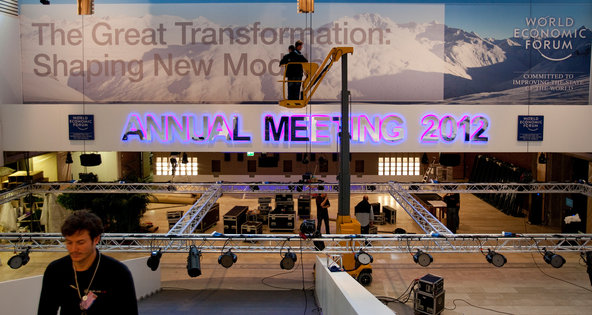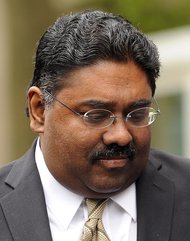 Scott Eells/Bloomberg NewsPreparations are under way for the World Economic Forum, which begins on Wednesday.
Scott Eells/Bloomberg NewsPreparations are under way for the World Economic Forum, which begins on Wednesday.
DAVOS, Switzerland — The stars of the guest list for this year’s annual World Economic Forum, which begins here Wednesday, are a who’s who of government leaders pulling the strings of the global economy. On the list are Angela Merkel, the chancellor of Germany; Timothy F. Geithner, the United States secretary of the Treasury; Mario Draghi, the president of the European Central Bank; and Christine Lagarde, the managing director of the International Monetary Fund.
The cost of their tickets? Nothing.
DealBook Column
View all posts
Last year, you may recall that I wrote a column detailing the extraordinary entrance fees that corporate executives pay for the opportunity to do matchmaking in the Alps. A quick refresher: It costs a minimum of $71,000 for an individual corporate invitation. An invitation for two that includes access to private events costs $301,000. An invitation for a delegation of five, $622,000. And that’s before the planes, hotels and restaurant meals.
But that column did not detail that for about 900 other individuals from the world of government, academia, nonprofit groups — and, yes, members of the media — the sky-high corporate fees also are waived. The invitation comes gratis, though all their travel and lodging costs fall to those guests.
You could argue that the more than $100 million that moguls and corporations spend to send 1,600 superconnected executives here by private plane is used to subsidize those who fly on commercial airlines. (In fairness, not every mogul flies by corporate jet: George Soros, the hedge fund manager, flew commercial. He was on my flight Sunday night.) And many public officials, of course, fly on private government planes. Mr. Geithner, for example, will be flying on a military plane.
Among those who get “comped” are often big and small nonprofit organizations and “social entrepreneurs” seeking a voice in the conversation and a chance to rub elbows with potential benefactors. People like Kumi Naidoo, the executive director of Greenpeace International, and Giorgio Jackson, the 24-year-old leader of a student movement in Santiago, Chile, that nearly paralyzed the country, are on the get-in-free list.
About 200 academics, people like the Nobel Prize-winning economist Joseph Stiglitz and Kenneth Rogoff, the Harvard economist and co-author of “This Time is Different,” are also offered free admission. And about 20 religious leaders, including Archbishop Desmond Tutu and Cardinal Peter Turkson of Ghana (who is said to be considered among the candidates to be the next pope), make the list.
It is a notable and noble effort by the World Economic Forum to take this multi-stakeholder approach and, in truth, it gives all kinds of people from all parts of the world a seat at the table, even if some say they are being co-opted by the “elite.” (By the way, since when did elite become a pejorative term?)
Critics contend that all of the nonbusiness leaders and high-minded conversations — this year’s theme is “The Great Transformation: Shaping New Models” — are a cover for the paying invitees to mingle in the halls and make deals. To some extent, that is true. There is no question that Davos is a matchmaking haven for chief executives. I know one executive who conducts more than 20 meetings a day with people from all over the globe that he said would otherwise take him three months of red-eye flights to do.
There is another, perhaps cynical, unspoken draw for the C.E.O. set paying six figures to frolic in the snow. The 40 heads of state and 90 ministers who come to the conference free of charge are, of course, the headliners, but they are also doing the real deal making behind the scenes with each other — and with industry.
For government officials, Davos has the same allure that it does for business: a series of quick-hit meetings with their counterparts. It gives executives the chance to jockey for position on the other side of the table with a government leader who could have an infrastructure project that needs financing, deals that can be worth millions if not billions of dollars. Or executives will spend weeks before arriving trying to get a 15-minute meeting with Mrs. Merkel or Ms. Lagarde in the hope of influencing the dialogue over the euro.
That may help explain why the World Economic Forum brought in $157 million in revenue last year from its members and strategic corporate partners.
In case you’re curious, it spent virtually all of it: $156 million. How was it spent? The organization employs 337 full-time employees and 369 “full-time equivalents” annually that it says cost a total of about $69 million. The conferences it convenes — besides the meeting in Davos, it organizes another big event in China and four other regional events — cost about $60 million more for space, elaborate signs and furniture, meals, event planning and security. (The security costs in Davos alone are estimated to be about $8 million, which are borne by the World Economic Forum and the Swiss government.) The organization says it spent another $26 million on office costs.
Adrian Monck, head of communications for the World Economic Forum, said that because there was such a cross-section of paying invitees from all kinds of industries, nobody could skew the selection of people invited to attend free. “The funding diversity means no one is ‘paying’ for the people we choose to come — that’s our ‘editorial integrity,’ ” he said in an e-mail.
Money may always raise questions about events like Davos. But in the end, the event is, as Mr. Monck wrote on his blog, an effort to convene a global conversation and a reflection that “that every view must be integrated, that one cannot simply abrogate one’s membership in a community. It is an old idea.”
Article source: http://feeds.nytimes.com/click.phdo?i=8a5f97000dcaeba29967092eb82f3e97







